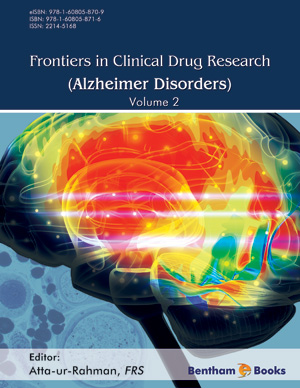Abstract
This chapter reviews the major pathological features and hypotheses in Alzheimer’s disease (AD). Hypothesis-based and mechanism-based strategies of clinical drug research and development for AD therapy and prevention are discussed. The current available drugs and their applications are described. In addition, the potential drugs in trials and under advanced stage of development are introduced.
AD displays 3 typical pathologies: loss of cholinergic neurons in the basal ganglia of forebrain, β-amyloid (Aβ) plague deposition and neurofibrillary tangles (NFTs) of tau protein. Aβ oliogmers and highly phosphorylated tau protein are generally considered to be critical factors for the pathogenesis of AD. AD is also aggravated by distress.
Primary and experimental drugs for AD based on these hypotheses are generally classified as follows: cholinergic drugs, antipsychotic drugs, Aβ and tau related drugs, neuroprotective drugs, others with atypical hypothesized mechanisms of action. As for patients, the drugs could be divided into drugs approved and drugs under clinical trials, while the approved ones include drugs to treat AD and drugs to treat AD associated symptoms.
As to the application of AD drugs, the most commonly prescribed drugs are classified as cholinesterase inhibitors. Memantine, antagonist of the NMDA receptor, is the second class of AD medicine that is approved for treatment of moderate to severe AD. Antidepressant, anxiolytics and antipsychotics are used to treat AD associated symptoms. Besides, antioxidant, statins, Non-steroidal anti-inflammatory drugs (NSAIDs) are those that belong to the family of “old drugs with new actions”. Nonprescription medications, like vitamin C and vitamin E, curcumin and ginko are probably advised to prevent AD. Another effort has been made towards metabolically non-reversible dimeric or hybrid compounds with multiple mechanisms of action.
The promising drugs loom in clinical trials since new strategies have been adopted to address the etiology of AD, i.e. Aβ, NFTs and neuronal loss. The tau related drugs include GSK-3β inhibitors, protein phosphatase 2A (PP2A) activators, paired helical filaments (PHF) antibody, and methylene blue with unknown mechanisms. Aβ related drugs include β-site APP-cleaving enzyme (BACE) inhibitors, γ-secretase inhibitors, γ- secretase modulators, active and passive Aβ vaccination drugs, and human intravenous immunoglobulin (IVIG). The neuroprotective drugs are those that would maintain the homeostasis of microenvironment, including anti-inflammatory, anti-oxyidant, metal chelators, statins and neurotrophic agents.
In conclusion, the patients would be prescribed tacrine, donepezil, rivastigmine, galantamine or memantine to treat mild or moderate to severe AD respectively. In the meantime, they would have taken antidepressants, anxiolytics and antipsychotics to deal with AD associated symptoms. Besides those approved, the effort to develop new drugs to cure AD never stops. The potential drugs are on their promising way through clinical trials. Albeit the failures and setbacks, AD scientists and clinicians are feverishly researching to deliver an effective therapy for the many patients.
Keywords: AD, amyloid, clinical trial, drug development, efficacy, neurodegeneration, neuronal loss, pathology, synaptic loss, tau, therapy.






















